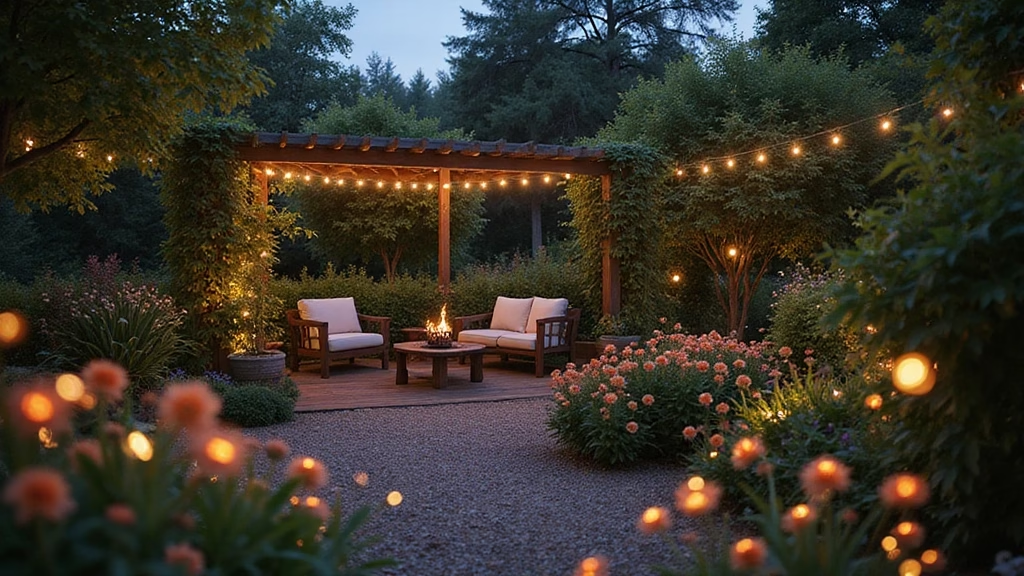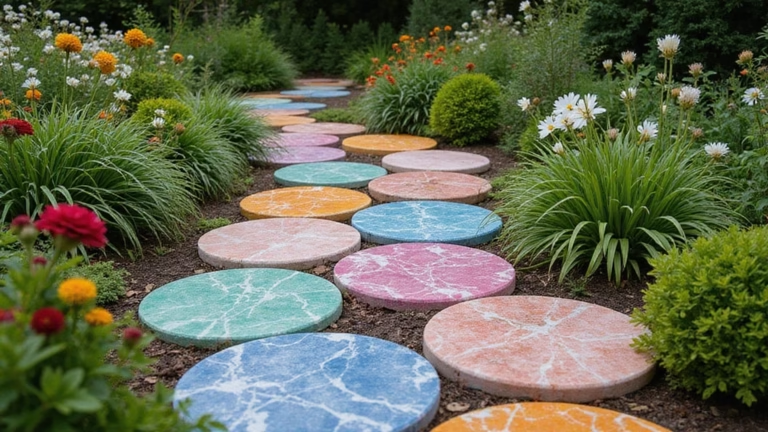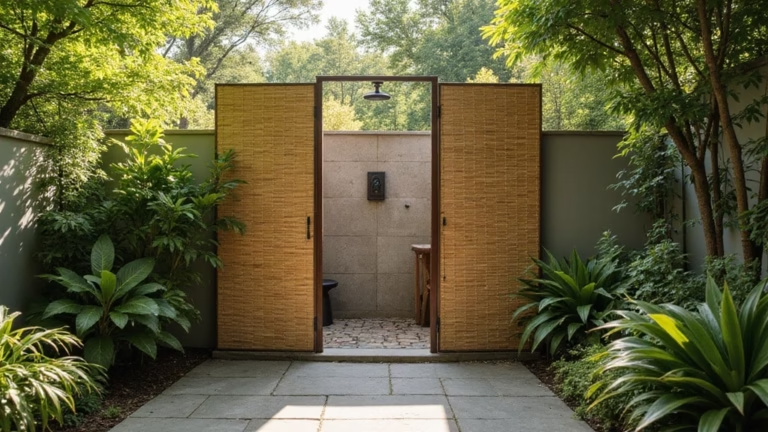Transform your outdoor space into a haven for fireflies while creating a serene evening retreat. These luminous insects thrive in specific habitats you can cultivate with thoughtful planting and lighting choices. Discover how to design a garden that supports local ecosystems and offers enchanting summer nights through practical, science-backed methods.
1. Science-Backed Plants for Firefly Attraction

Fireflies rely on specific plants throughout their lifecycle. Prioritize these research-supported varieties:
– Native groundcovers: Pennsylvania sedge (Carex pensylvanica) and native violets provide essential daytime shelter
– Moisture-retaining plants: Ferns like ostrich (Matteuccia struthiopteris) and cinnamon (Osmundastrum cinnamomeum) maintain humidity
– Nectar sources: Milkweed (Asclepias), goldenrod (Solidago), and bee balm (Monarda) sustain adult fireflies
– Host plants: Native grasses like switchgrass (Panicum virgatum) support larval development
Cluster these plants near wooded edges or water sources where fireflies naturally congregate. Avoid pesticides, which disrupt their reproductive cycle.
2. Essential Moisture Management

Fireflies require consistent moisture for survival. Implement these effective strategies:
– Strategic water features: Install shallow dishes with rocks (prevents drowning) or create drainage swales
– Smart mulching: Apply 2-3 inches of leaf mold or hardwood mulch to retain soil moisture
– Shade optimization: Plant native shrubs like spicebush (Lindera benzoin) to create cool microclimates
– Rain garden installation: Designate low-lying areas to collect rainwater naturally
These solutions maintain necessary humidity while reducing water usage—ideal for eco-conscious gardeners.
3. Night-Friendly Lighting Solutions

Artificial lighting disrupts firefly mating signals. Balance safety and ambiance with these solutions:
– Amber LED lights: Install 560nm wavelength bulbs (less disruptive than white light)
– Directional fixtures: Focus lights downward with full cutoff shields
– Motion sensors: Illuminate paths only when needed
– Strategic placement: Keep lights 30+ feet from firefly habitats
Prioritize pathway lighting over area illumination to preserve dark zones where fireflies communicate.
4. Habitat Preservation Techniques

Fireflies need undisturbed areas for their 1-2 year larval stage. Create sanctuary zones with these methods:
– Designated wild corners: Leave leaf litter and fallen logs in shaded areas
– Chemical-free maintenance: Use neem oil or insecticidal soap instead of synthetic pesticides
– Soil protection: Avoid excessive tilling where larvae develop
– Native groundcover islands: Create undisturbed patches of native vegetation
These practices support fireflies while promoting overall garden biodiversity.
5. Seasonal Garden Maintenance

Support fireflies through all life stages with timed care:
– Early spring: Delay cleanup until temperatures reach 50°F consistently
– Summer: Water deeply twice weekly during dry spells
– Fall: Leave seed heads standing and create leaf pile shelters
– Winter: Maintain undisturbed soil where larvae overwinter
This approach protects fireflies while reducing maintenance labor.
6. Strategic Hardscaping

Incorporate functional elements that support fireflies:
– Heat-retaining stones: Place flat rocks in sunny spots for daytime basking
– Natural pathways: Use pine needle mulch or permeable pavers for ground-nesting species
– Moisture zones: Create gravel drainage areas near water features
– Habitat structures: Install untreated wood borders to contain wild areas
These features provide practical benefits while defining garden spaces.
7. Creating Personal Retreat Spaces

Design comfortable observation areas:
– Weather-resistant seating: Choose teak or recycled plastic benches near prime viewing zones
– All-weather textiles: Use solution-dyed acrylic cushions for durability
– Strategic placement: Position seating downwind from aromatic plants
– Minimalist design: Select simple furniture that blends with natural surroundings
Create an inviting space for relaxation without disrupting firefly habitats.
8. Supporting Beneficial Wildlife

A balanced ecosystem supports firefly populations:
– Amphibian habitats: Install small pond features for frogs that eat firefly predators
– Native shrub borders: Plant elderberry or serviceberry for nesting birds
– Pollinator support: Include continuous-bloom natives like anise hyssop
– Predator management– Predator management: Encourage spiders by preserving web-friendly structures
This holistic approach reduces pests naturally while supporting firefly survival.
9. Optimized Viewing Strategies

Maximize firefly viewing experiences:
– Timing: Observe during peak hours (30-60 minutes after sunset)
– Positioning: Face east to avoid interfering with firefly light signals
– Dark adaptation: Allow 20 minutes for eyes to adjust naturally
– Minimal disturbance: Use red-filtered flashlights when necessary
These science-based techniques enhance observation while protecting firefly behavior.
10. Sensory Plant Selection

Select plants that enhance evening experiences:
– Night-blooming species: Moonflower (Ipomoea alba) and evening primrose (Oenothera biennis)
– Tactile foliage: Lamb’s ear (Stachys byzantina) and silver mound artemisia
– Sound elements: Ornamental grasses like maiden grass (Miscanthus)
– Edible options: Pineapple sage and lemon balm near seating areas
These multi-sensory plants create immersive evening environments.
11. Educational Opportunities

Deepen your firefly knowledge:
– Citizen science: Participate in Firefly Watch (Mass Audubon)
– Local workshops: Check nature centers for firefly ecology classes
– Digital resources: Access Firefly.org species identification guides
– Journaling: Document first/last seasonal sightings for personal reference
These activities enrich the gardening experience with scientific understanding.
12. Natural Pest Management

Protect fireflies with eco-friendly pest control:
– Barrier methods: Floating row covers for vegetable gardens
– Biological controls: Introduce beneficial nematodes for soil-dwelling pests
– Botanical sprays: Use garlic or chrysanthemum-based solutions sparingly
– Trap cropping: Plant nasturtiums as aphid distractors
These methods effectively manage pests without harming firefly larvae.
13. Low-Impact Garden Enjoyment

Enjoy your garden responsibly:
– Small gatherings: Limit group sizes to minimize habitat disturbance
– Designated pathways: Install stepping stones to prevent soil compaction
– Reusable elements: Choose durable serveware instead of disposables
– Sound management: Keep music volume low to avoid disrupting wildlife
These practices allow enjoyment while protecting your firefly habitat investment.
14. Community Engagement

Expand your impact beyond your garden:
– Habitat corridors: Coordinate with neighbors to create connected green spaces
– Native plant swaps: Organize local exchanges of firefly-supporting plants
– Advocacy: Support municipal lighting ordinances that protect nocturnal wildlife
– Knowledge sharing: Host small demonstrations of firefly-friendly techniques
Collective action significantly enhances firefly conservation efforts.
15. Sustainable Gardening Mindset

Adopt these long-term approaches:
– Progressive implementation: Transform your garden in phases over 2-3 years
– Observation practice: Spend 10 minutes daily noting insect activity
– Adaptive management: Adjust techniques based on seasonal observations
– Native prioritization: Gradually replace non-natives with local species
This mindful approach creates lasting habitats while reducing gardener burnout.
Conclusion

Creating a firefly-friendly garden delivers both ecological impact and personal fulfillment. By implementing these research-supported techniques, you’ll provide essential habitat for declining firefly populations while establishing a serene evening sanctuary. The reward comes in summer’s quiet moments, watching these natural wonders thrive through your thoughtful stewardship. Your garden becomes a living testament to harmonious coexistence with nature.








